
While the iPhone 12 is the latest and greatest, Apple is still selling the iPhone 11 as part of its lineup of new iPhones. Furthermore, many existing iPhone 11 users are likely wondering whether the iPhone 12 justifies an upgrade. Read on as we round up all of the details on the iPhone 11 vs. iPhone 12, and which you should buy in 2021.
In this comparison, we focus on the 6.1-inch iPhone 11 versus the 6.1-inch iPhone 12. There are similarities between the iPhone 12 mini and iPhone 12, but we aren’t focusing on that here.
- iPhone 12 vs. iPhone 12 Pro: Which should you buy?
- iPhone 6 vs. 2020 iPhone SE: Here’s why you should upgrade
- iPhone SE vs. iPhone XR comparison: Which should you buy?
- iPhone 12 Pro vs. iPhone 12 Pro Max: Which should you buy?
iPhone 11 vs iPhone 12: Display
One of the most noticeable differences between the iPhone 11 and the iPhone 12 is the display. The iPhone 11 features an LCD “Liquid Retina” panel with a 1792-by-828 pixel resolution. That comes out to 326 pixels-per-inch. This is notably lower than the resolutions of 458 pixels-per-inch found on the iPhone 12.
The iPhone 12 features a resolution of 2532-by-1170 pixels, but perhaps even more notably, it uses OLED display technology. This means you get improved colors and deeper blacks on the iPhone 12, alongside a wider dynamic range, a higher contrast ratio, and HDR support.
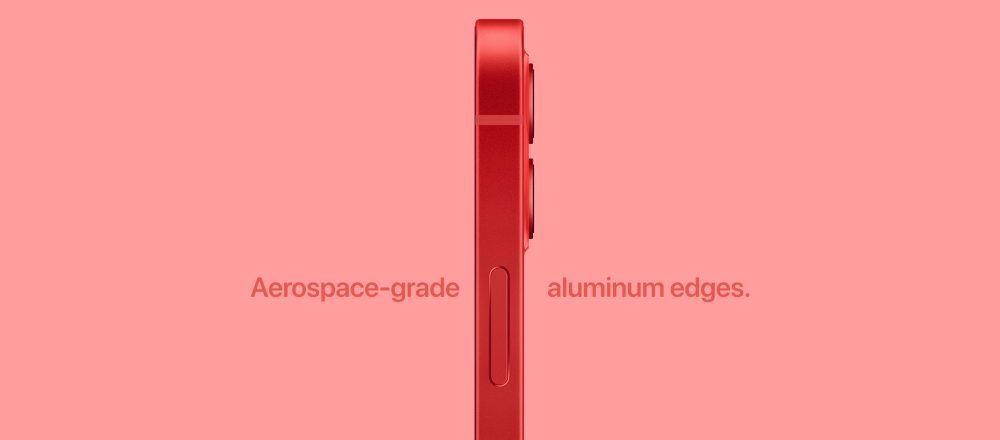
iPhone 11 display specs:
- Liquid Retina HD display
- 6.1-inch all-screen LCD display with IPS technology
- 1792-by-828-pixel resolution at 326 ppi
- 1400:1 contrast ratio (typical)
- True Tone display
- Wide color display (P3)
- Haptic Touch
- 625 nits max brightness (typical)
iPhone 12 display specs:
- Super Retina XDR display
- 6.1-inch all-screen OLED display
- HDR display
- 2532-by-1170-pixel resolution at 460 ppi
- 2,000,000:1 contrast ratio (typical)
- True Tone display
- Wide color display (P3)
- Haptic Touch
- 625 nits max brightness (typical)
- 1200 nits max brightness (HDR)
Finally, the iPhone 12 display is protected by what Apple calls Ceramic Shield technology, which offers 4x better drop performance than previous iPhones. The iPhone 11 does not feature this technology, so it could be more susceptible to cracks and other damage when dropped.
Design and size

As you can see, the iPhone 11 and iPhone 12 feature the same physical screen size at 6.1-inches. That being said, the iPhone 12 is actually slightly smaller, thinner, and lighter because of its new design and reduced bezels. Both devices feature matte aluminum edges and the backs have a glossy finish.
Here are the iPhone 11 dimensions:
- Height – 5.94 inches (150.9 mm)
- Width – 2.98 inches (75.7 mm)
- Depth – 0.33 inch (8.3 mm)
- Weight – 6.84 ounces (194 grams)
Here are the iPhone 12 dimensions:
- Height – 5.78 inches (146.7 mm)
- Width – 2.82 inches (71.5 mm)
- Depth – 0.29 inch (7.4 mm)
- Weight – 5.78 ounces (164 grams)
The iPhone 11 features a rounded body with curved edges, whereas the iPhone 12 features a flat-edged design similar to the iPad Pro and reminiscent of the days of the iPhone 4 and iPhone 5. Theoretically, this should make the iPhone 12 easier to hold and grip, but this is likely up to personal preference.
Both the iPhone 11 and the iPhone 12 are rated for IP68 splash, water, and dust resistance. Under this rating, the devices can withstand submersion at a maximum depth of 6 meters for up to 30 minutes.
Best iPhone 12 cases:
- Caseology Nano
- ESR Air
- TORRAS Ultra Slim Case
- ESR Leather
Performance and battery life

Another area where the iPhone 11 and the iPhone 12 differ is in regard to processor performance. The iPhone 12 has Apple’s latest A14 Bionic processor, which Apple touts is “the fastest chip in a smartphone.” The A14 Bionic features two high-performance cores and four efficiency cores.
The iPhone 12 also features the latest Neural Engine for improved machine learning features and capabilities. Apple says the new 16-core Neural Engine offers an 80% increase in performance compared to the prior generation.
On the flip side, the iPhone 11 is powered by Apple’s A13 Bionic processor as well as the third-generation Neural Engine. Even though it’s not Apple’s latest and greatest silicon, the A13 Bionic processor ensures that the iPhone 11 will receive software updates for many years.
In terms of battery life, Apple claims both models have the same specs, though
Here are the iPhone 11 battery claims from Apple:
- Video playback: Up to 17 hours
- Video playback (streamed): Up to 10 hours
- Audio playback: Up to 65 hours
Compared to the new claims for the iPhone 12:
- Video playback: Up to 17 hours
- Video playback (streamed): Up to 11 hours
- Audio playback: Up to 65 hours
Both devices support fast-charging for getting an up to 50% charge in 30 minutes, but the iPhone 12 also supports 15W wireless charging when using Apple’s MagSafe Charger. The iPhone 11 can charge via the MagSafe charger, but it does not feature the necessary magnetic system to accommodate 15W speeds. Instead, it’s limited to 7.5W.
Connectivity
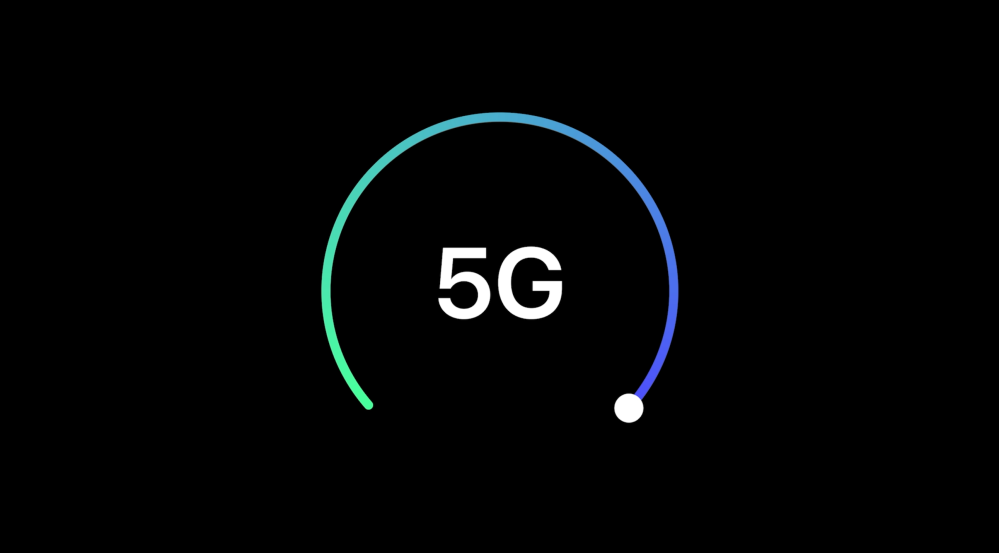
The iPhone 12 is the first iPhone to include 5G connectivity, which is rolling out at various speeds and on various timelines from carriers around the world. In the United States, the iPhone 12 supports sub-6GHz 5G as well as mmWave 5G. Internationally, however, iPhone 12 5G support is limited to sub-6GHz connectivity.
There is quite a bit of debate as to the importance of 5G right now, but ultimately it comes down to what’s available in your area from your cell carrier. If a form of 5G is available in your area, the iPhone 12 supports it, but if not, you’ll fall back on LTE.
On the other hand, the iPhone 11 is limited to 4G LTE connectivity. This means you can connect to LTE networks, and achieve what Apple refers to as “Gigabit-class LTE.”
Camera
The iPhone 11 and iPhone 12 both feature dual-camera arrays on the back with 12MP wide and ultra wide lenses. The difference here is that the iPhone 12 features an upgraded wide angle lens with a ƒ/1.6 aperture, compared to the ƒ/1.8 aperture in the iPhone 11.

What this means is that more light can enter the camera, thereby improving low-light photography and video performance. In fact, Apple says that the new wide camera allows for 27% more light than the iPhone 11 camera.
Harnessing the power of the A14 and the new Neural Engine, the iPhone 12 also supports Night mode and Deep Fusion on the ultra wide lens for the first time. There is also a new Smart HDR 3 system, which Apple says uses machine learning to intelligently adjust the white balance, contrast, texture, and saturation of a photo for natural-looking images.
Other camera features are the same between both devices:
- Optical image stabilization
- 2x optical zoom out
- Digital zoom up to 5x
- Brighter True Tone flash with Slow Sync
- Portrait mode with advanced bokeh and Depth Control
- Portrait Lighting with six effects (Natural, Studio, Contour, Stage, Stage Mono, High‑Key Mono)
For the front-facing camera, the iPhone 11 and iPhone 12 are essentially the same, but the iPhone 12 packs a handful of notable software updates:
- Night mode
- Deep Fusion
On the video side of things, the iPhone 12 supports HDR video recording with Dolby Vision up to 30 fps, as well as Night mode time-lapse support. Other video features are the same between the iPhone 11 and iPhone 12:
- 4K video recording at 24 fps, 30 fps, or 60 fps
- 1080p HD video recording at 30 fps or 60 fps
- Extended dynamic range for video up to 60 fps
- Optical image stabilization for video
- 2x optical zoom out
- Digital zoom up to 3x
- Audio zoom
- QuickTake video
- Slo-mo video support for 1080p at 120 fps or 240 fps
- Time-lapse video with stabilization
- Stereo recording
The iPhone 12 front-facing camera also supports HDR video recording with Dolby Vision up to 30 fps.
Best iPhone 11 cases:
- Spigen Ultra Hybrid for iPhone 11
- Mujjo Full Leather Case for iPhone 11
- Case-Mate Slim Case for iPhone 11
Colors, storage, and pricing
The iPhone 12 is available in five different colors: black, white, PRODUCT(RED), green, and blue. It starts at $829 (or $799 for Verizon, T-Mobile, Sprint, AT&T) for 64GB of storage. You can upgrade to the 128GB configuration for $879 ($849 for Verizon, T-Mobile, Sprint, AT&T), or to the 256GB model for $979 ($949 for Verizon, T-Mobile, Sprint, AT&T).
The iPhone 11 now starts at $599 for 64GB of storage, $649 for 128GB, or $749 for 256GB. It’s available in white, black, green, yellow, purple, and PRODUCT(RED).
Included accessories
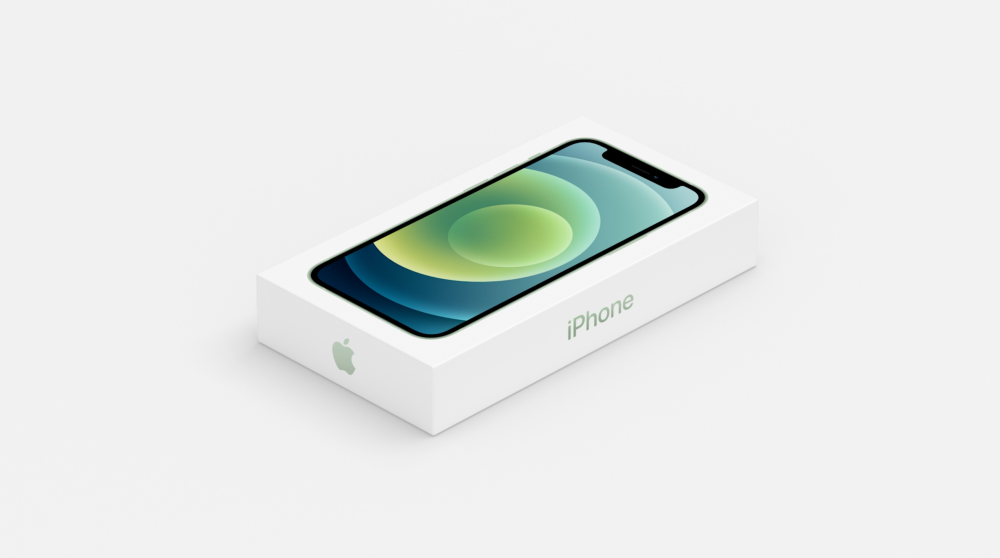
Citing environmental concerns, Apple is no longer including headphones or a charging brick in the iPhone 12 box this year. Apple has also extended this down the line, so the iPhone 11 also no longer includes a charging brick or EarPods in the box. Here are some accessories you might consider picking up to help fill that gap.
- Native Union Drop 10W Qi Charger
- Anker 30W USB-C wall charger
- Extra-long braided Lightning to USB-C cable
- Lightning to 3.5mm headphone adapter or cable
iPhone 11 vs iPhone 12 features
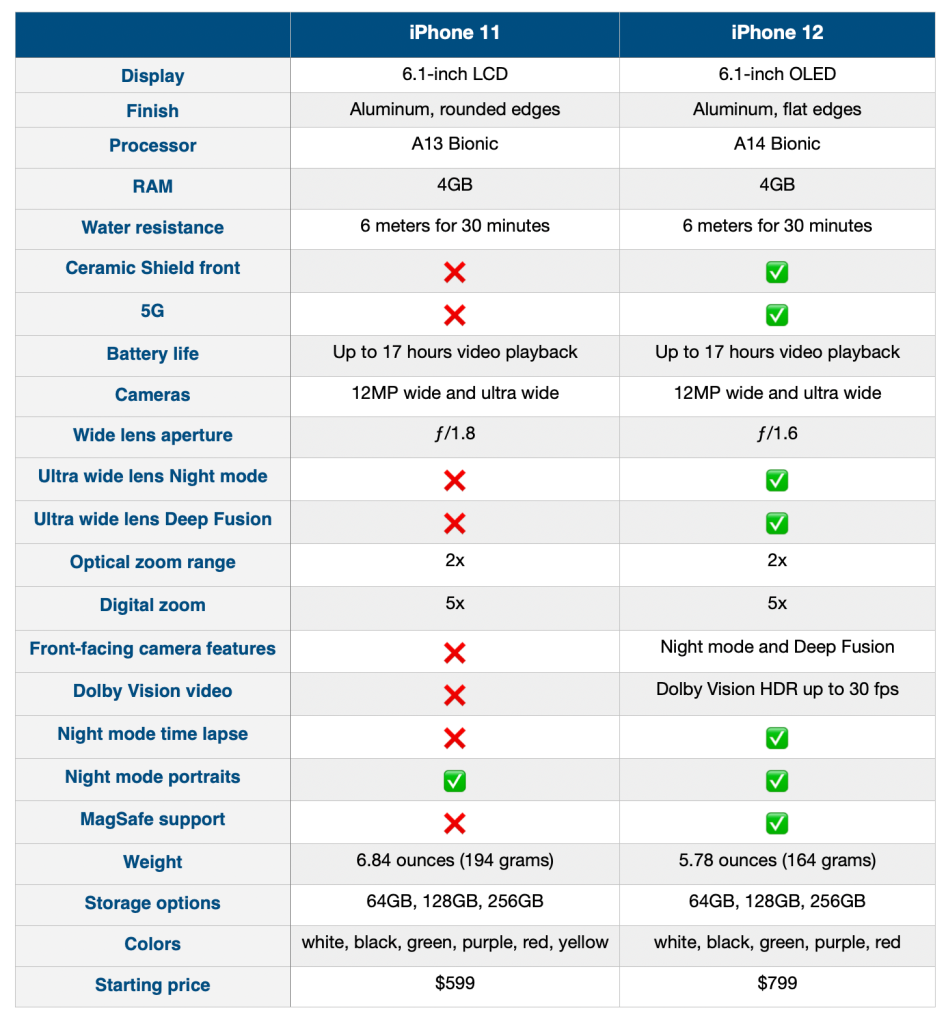
Wrap-up: iPhone 11 vs iPhone 12
The iPhone 12 is a notable upgrade in more ways than one. In addition to an all-new design that’s smaller and lighter, you also get an OLED display for the first time in a non-Pro iPhone. You also get the latest A14 Bionic processor and serval significant camera enhancements.
Then, there’s the factor of 5G connectivity. In the United States and many other counties, top-end 5G speeds are not yet widespread, but the iPhone 12 is future-proofed to support those speeds once they’re available in your area. The iPhone 11 maxes out at LTE connectivity.
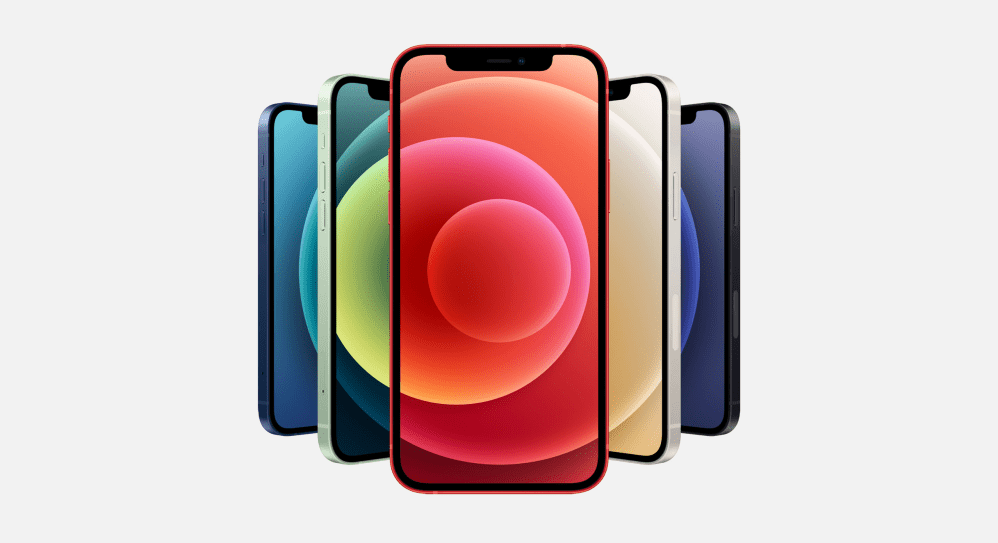
If you’re a current iPhone 11 user, there are a variety of reasons to upgrade, including the new design and improved camera functionality. What we don’t recommend is upgrading purely based on the promise of 5G connectivity. This might vary based on where you live, but for many iPhone 11 users, LTE is fast enough.
If you’re buying a brand new iPhone, or upgrading from something older than iPhone 11, it’s hard to resist the new iPhone 12 design and features, even though it comes at a $200 premium versus the iPhone 11. If you spend the extra money for an iPhone 12 today, however, it will last you for many years and is future-proof thanks to its 5G connectivity, A14 Bionic processor, and dual-camera system.
What about the iPhone 13?
As you’ve likely seen, rumors about the iPhone 13 or iPhone 12S are starting to gain traction, but tthis year is expected to be an “S” year upgrade over the iPhone 12. We’re also still at least 6 months away from the announcement of the iPhone 13, so the iPhone 12 and iPhone 11 are still excellenet purhcases — especially if you can find them with a promotion from a carrier or retailer.
You can keep up with the latest iPhone 13 rumors in our full roundup right here.
Author: Chance Miller
Source: 9TO5Google



